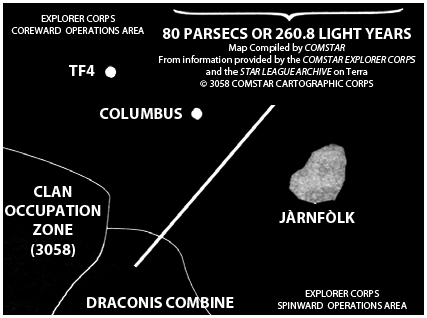Difference between revisions of "Epsilon Pegasus"
Sarna News

- HEXTECH Review - Wave 3 Brings More Urban Options To Your Battlefield
- Your BattleTech News Round-Up For March, 2024
- Crashing 'Mechs With Jennifer Brozek, Author Of The Rogue Academy Trilogy
- Getting The Word Out With Rem Alternis, Catalyst Community & Marketing Director
- Bad 'Mechs - Yeoman
- Read more →
m ({{e}}) |
m |
||
| Line 66: | Line 66: | ||
[[Category: Planets|Columbus]] | [[Category: Planets|Columbus]] | ||
[[Category: SLDF Facilities]] | [[Category: SLDF Facilities]] | ||
| − | [[Category: | + | [[Category:ComStar Planets]] |
[[Category:Terran Hegemony Planets]] | [[Category:Terran Hegemony Planets]] | ||
Revision as of 05:01, 17 October 2011
(References to Columbus)
Note: X and Y are coordinates (light years on XY plane) relative to Terra at (0, 0)
The fourth planet of the Epsilon Pegasus system, Columbus is the name of an Age of War research facility and Deep Periphery base of operations used by the Terran Hegemony, the Star League, and Comstar's Explorer Corps. Columbus lies anti-spinward of the JàrnFòlk, and coreward of the Draconis Combine. The text quotes an approximate distance of "270 light years coreward of Nowhere"[1], however the Explorer Corps map of the Deep Periphery depicts Columbus as approximately 150 light years coreward of Nowhere[2].
Contents
History
Columbus was founded in 2549 by Terran Hegemony Deep Periphery exploration crews. The settlement started with a research and boarding facility for deep space exploration, and is located in the center of a crater, situated on one of the two northern continents near the equator. At the time of discovery, settling the facility near the equator was imperative because the planet was in the midst of an ice age.
After the founding of the Star League and the end of the Reunification War, the facility was expanded. Initial expansion included added tarmac and runways, paved roads, warehouses, lodging, a small town, and a garrison. By 2641, the facility also included a Dropship maintenance/repair facility. This facility included moving platforms large enough to ferry a 20,000 ton Dropship off the runways. Further, an orbital dry dock was constructed in the excavated core of Columbus's small moon.
Columbus remained active through the Amaris Civil War, but was evacuated in 2780 shortly before the Exodus of General Aleksandr Kerensky and most of the SLDF from the Inner Sphere.
The Comstar Explorer Corps vessel ECV Von Braun discovered the abandoned facilities during a survey of the Epsilon Pegasus system in 3023. Having determined the fourth planet was most likely to be inhabitable by humans, the crew spent two weeks in orbit over the planet, and discovered the facility because of the large runways, visible despite being overgrown for nearly 250 years. The name Columbus and its original use by the SLDF was only possible because the facilities computer core was still active. The Explorer Corps survey teams removed all valuable LosTech form the facility, and established a rudimentary base and departure point for exploration.
The Explorer Corps began further upgrades of the facility in 3053. The upgrades included the installation of Explorer Corps field offices, revitalization of the repair and maintenance facilities, barracks, hardened hangars for AeroSpace Fighters, cinemas, sports bars, taverns, night clubs, a Hyperpulse Generator, new radio telescopes and other scientific facilities, and a sizable farming village. Comstar has also revitalized the large dry dock orbiting the planet.
Manufacturing Centers
Columbus is home to a shipyard capable of working on capital-scale vessels. However, the specifics, for instance whether this shipyard is solely capable of making repairs, or if the shipyard is manufacturing new vessels, is unstated. Comstar's other listed shipyard, the Newgrange Factory Yards (location unclear), is the likely production facility of the Faslane-class "yard-ships", essentially a mobile capital ship repair facility. The Faslane is derived from the Star League-era Newgrange-class capital ship.
Owner History
- 2570 - Terran Hegemony
- 2750 - Terran Hegemony
- 3025 - Unknown Planet
- 3030 - Comstar
- 3040 - Comstar
- 3052 - Comstar
- 3057 - Comstar
- 3062 - Comstar
Nearby Systems
There are no known inhabited systems within 60 light years.


